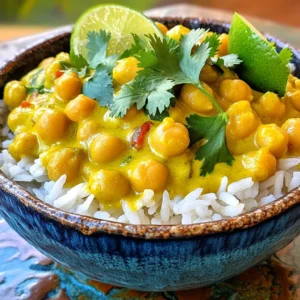
Coconut Curry Chickpeas
A flavorful and creamy coconut curry dish featuring chickpeas, perfect for a quick and satisfying meal.
Ingredients
- 2 cups canned chickpeas, drained and rinsed
- 1 can coconut milk (13.5 oz)
- 1 medium onion, finely chopped
- 3 cloves garlic, minced
- 1 inch piece ginger, freshly grated
- 2 tablespoons red curry paste
- 1 tablespoon extra virgin olive oil
- 1 tablespoon soy sauce
- 1 teaspoon turmeric powder
- 1 teaspoon ground cumin
- to taste salt
- for garnish fresh cilantro, roughly chopped
- for serving cooked basmati rice
Instructions
- In a large skillet, heat the extra virgin olive oil over medium heat. Once hot, add the finely chopped onion. Sauté for about 4-5 minutes, stirring occasionally, until the onion is softened and translucent.
- Stir in the minced garlic and freshly grated ginger. Cook for an additional 1-2 minutes until the mixture becomes fragrant, ensuring the garlic doesn’t burn.
- Add the red curry paste to the skillet, stirring thoroughly to coat the onions and release the spices. Cook for another minute to enhance the flavor profile of the dish.
- Pour in the rich coconut milk along with the soy sauce, turmeric powder, and ground cumin. Mix well to combine all the ingredients, then bring the mixture to a gentle simmer.
- Carefully add the drained chickpeas to the skillet, stirring gently to ensure they are well coated with the vibrant curry sauce.
- Allow the curry to simmer for approximately 15 minutes. This will give time for the flavors to meld beautifully and for the sauce to thicken slightly. Taste and season with salt as necessary.
- Once finished, remove the skillet from the heat. Garnish the dish generously with fresh chopped cilantro just before serving.
Notes
Serve over basmati rice and garnish with cilantro and lime for added freshness.